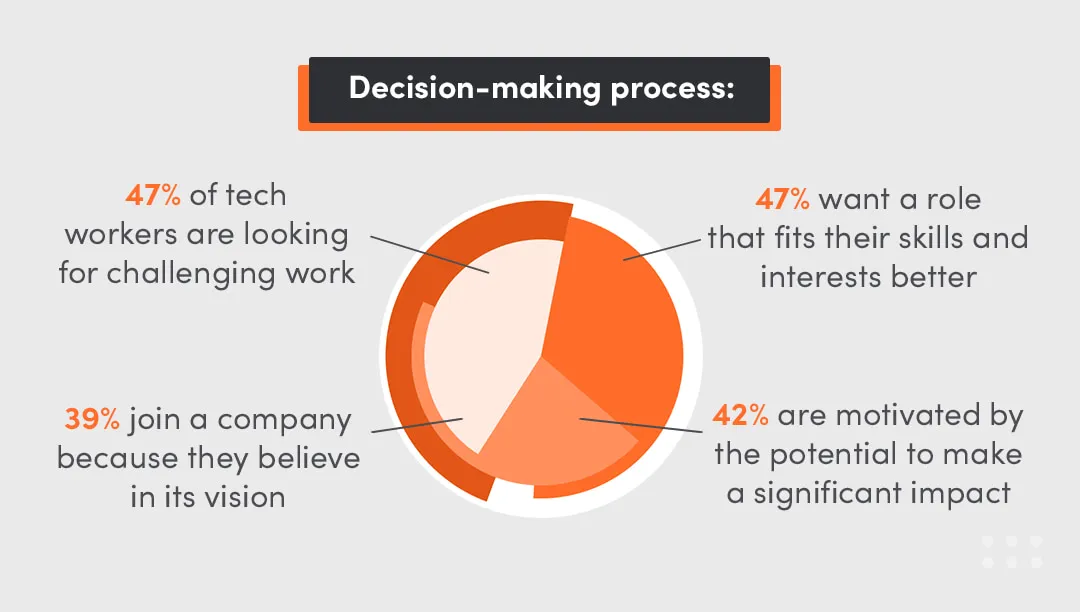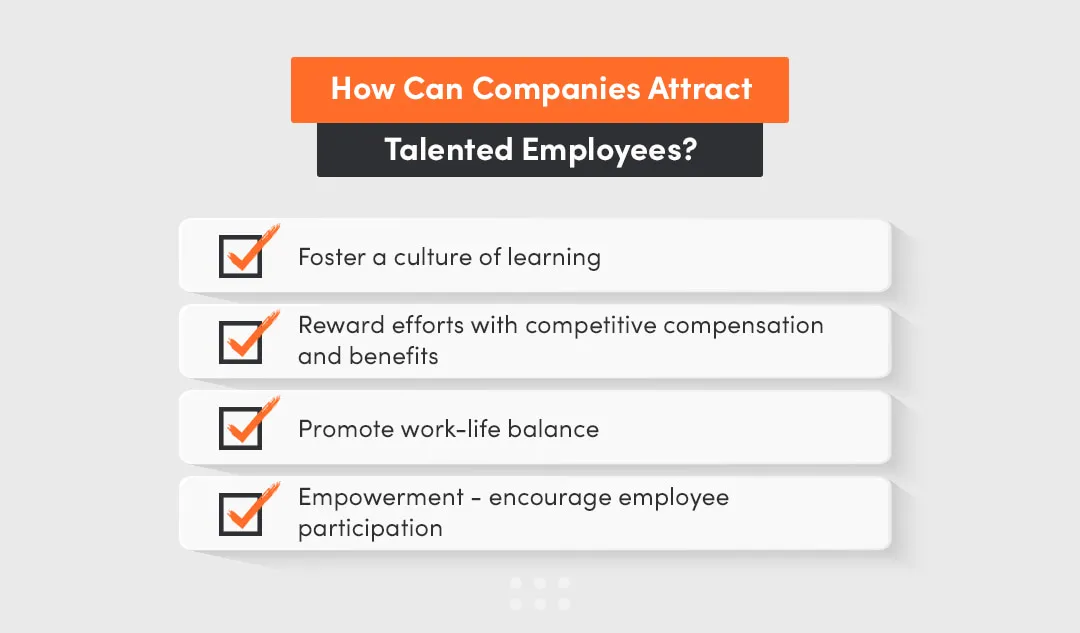In today's competitive job market, it's crucial to know how to attract top tech talent to your organization and understand what keeps them there.
Insights from recent LinkedIn research reveal an important shift in what motivates tech professionals today. Surprisingly, it’s not just about salary and perks. The number one reason people cited for joining a company was the opportunity for career advancement. Specifically, 59% of respondents said they were drawn to their current roles because they saw a chance for a stronger career path and more opportunities, followed closely by better compensation and benefits at 54%.

Other factors also play significant roles in their decision-making process: 47% of tech workers are looking for challenging work, another 47% want a role that fits their skills and interests better, and 42% are motivated by the potential to make a significant impact. Additionally, 39% join a company because they believe in its vision.
Further deepening our understanding of what retains these talents, the ISL Retention Report highlights key cultural elements valued within companies. Communication tops the list, deemed crucial by 82% of respondents, followed closely by a clear company mission and values at 79%, and a positive team and office environment at 78%.
This shift from viewing compensation and benefits as the ultimate job incentives highlights that scaleups need to rethink their approach to recruitment and retention.
Today’s tech talent is searching for more than a good salary package. They want a role that promises personal and professional growth, engaging projects, and a sense of purpose.
This article will explore the key strategies scaleups must implement to attract and retain top tech talent in today’s competitive job market.
What will you learn from this article?
- How can companies attract talented employees?
- Why the culture of innovation and creativity is important and why it matters to employees
- Importance of a career path in your business
- How companies can retain talented employees
- The concept of an effective innovation environment
-
The primary motivator for tech professionals joining a company is the opportunity for career advancement (59% of respondents).
-
Developing clear career development plans and mentoring programs is essential for employee retention and growth.
-
Implementing flexible work schedules and policies like unlimited PTO can enhance employee satisfaction and reduce turnover.
-
Creating an environment where employees can take risks and voice opinions without fear is crucial for fostering effective teamwork and innovation.
-
Clear career paths attract top talent and retain current employees.
-
Junior managers are challenging to retain; 60% leave for better advancement opportunities.
-
Talent management programs reportedly increase success in keeping junior managers by 18%.
-
Regular communication about career paths, ongoing training, and mentoring improves employee retention.
How Can Companies Attract Talented Employees?
To attract top talent, companies need to ensure they're not just seen as a place to work, but as a place where careers flourish. This begins with a strong employer brand. Potential employees’ perception of your company can significantly influence their decision to apply.
According to a Dice survey, nearly 90% of technology professionals emphasized the importance of an employer’s brand when considering new job opportunities.
A robust employer brand can make your company a magnet for talent, while a negative one might push away even the most qualified candidates. The following are some effective strategies that can help your organization attract talented employees.

Foster a Culture of Learning
Career development plans are key to retaining and developing your most promising employees. These plans should outline clear paths for advancement and be customized to match each employee’s career goals and skills. Regularly discussing these career paths and providing transparent feedback about opportunities for growth shows your commitment to each team member’s long-term success. This approach not only retains top talent but also equips them to take on key roles within your organization.
Additionally, your organization can produce, develop, and retain high-potential employees through mentoring programs.
When you pair these individuals with seasoned leaders, they gain invaluable insights into leadership techniques and the complexities of the organization.
Besides knowledge transfer, mentoring provides essential emotional support, helping employees confidently navigate their careers. This emotional support, combined with strong interpersonal relationships developed through the program, deepens employees' commitment to the organization, thus reducing the likelihood of them leaving.
Reward Efforts With Competitive Compensation and Benefits
It's crucial to recognize and reward your high-potential employees to keep them engaged and committed. Effective recognition goes beyond just monetary rewards - it can include public praise, trust in other responsibilities, or access to personal development resources. Cultivating a culture where contributions are acknowledged not only fosters a sense of value among team members but also significantly boosts employee retention.
Promote Work-life Balance
Interestingly, about 60% of workers would decline a job they believe would negatively impact their work-life balance.
To support your employees, consider implementing flexible work arrangements such as remote or hybrid schedules, and respecting personal time with policies like unlimited PTO. Additionally, fostering stress-reducing activities like team socials can help prevent burnout.
Empowerment - Encourage Employee Participation
Empowering your employees by involving them in decision-making and strategic planning boosts their sense of belonging and commitment. This approach not only recognizes their expertise and potential for leadership but also gives them a clearer understanding of their role in achieving company goals.
By fostering an environment where every voice is heard and valued, you enhance employee engagement and loyalty, which are key to retaining top talent.
How Does Creating a Culture of Innovation and Creativity Impact Your Employees?
Building a culture of innovation and creativity requires ongoing commitment at all organizational levels. It involves clearly communicating your vision and empowering employees with autonomy and resources to explore new ideas. Besides, recognizing efforts - whether they lead to success or failure - helps create a supportive environment that encourages risk-taking and continuous learning.
This dynamic culture boosts creativity and supports job retention by making employees feel integral to the company's success. Let’s explore in more detail, how creating a culture of innovation and creativity impacts your employees.
Environment Conducive to Innovation
To foster an effective environment for innovation, it's crucial to support creativity - both structurally and culturally. This concept is well illustrated by the models developed by Teresa Amabile and Göran Ekvall:
Amabile’s Climate for Creativity model centers on three critical elements: resources, management practices, and organizational motivation. The model uses a Likert-type scale to assess how these factors are perceived and performed in the workplace. It highlights the importance of granting autonomy, offering encouragement, and providing constructive feedback, all essential for stimulating creative thinking and problem-solving. Work environments that support these practices promote collaborative and open communication, which is crucial for generating and integrating a wide range of ideas.
Ekvall’s Creative Climate model, developed shortly after Amabile’s, outlines ten dimensions that measure the atmosphere and attitudes toward work, which are pivotal for fostering creativity. These dimensions include elements, such as challenge, freedom, idea support, and risk-taking, which are also assessed using a Likert-type scale. Ekvall’s model highlights the importance of giving employees time for idea development, encouraging them to take risks, and deeply involving them in their tasks. Employees tend to feel more motivated and engaged in such environments, fostering a dynamic and inspiring workplace where innovation thrives.
Psychological safety
Psychological safety is crucial in the workplace as it establishes a foundation where employees can freely take risks and voice their opinions without fear of judgment or punishment. Harvard Professor Dr. Amy Edmondson defines this concept as a team's collective confidence that their environment supports interpersonal risk-taking. She emphasizes the detrimental effects of a blame and shame culture, advocating instead for a supportive atmosphere that fosters trust and mutual respect, where everyone feels comfortable sharing ideas essential for the organization’s success.
Google's extensive research also highlights the importance of psychological safety, identifying it as a key factor distinguishing their most effective teams. Their findings reveal that high-performing teams engage in empathetic interactions and proactively seek contributions from all members, a process described by Edmondson as "teaming." This behavior enables teams to perform optimally and highlights the need for leaders to actively foster a psychological safety environment. As such, understanding and promoting this concept should be a central goal in the training and evaluation of managers and team leaders.
Culture Eats Strategy for Breakfast
Peter Drucker famously remarked, "Culture eats strategy for breakfast," highlighting that the success of any company relies more on its organizational culture than its strategic plans. This idea stresses the vital role of the human element within a company. No matter how well-designed a strategy is, its success ultimately depends on the people implementing it.

Drucker noted that it's not the office perks or aesthetics that define a company's culture, but rather how employees handle pressure, face challenges, and interact with colleagues, customers, and partners. The underlying message is that a company's culture, largely shaped by its founders and leaders through actions rather than words, is crucial in effectively carrying out strategies. If the workforce isn't in sync with the company's vision, even the best strategies can fail. Ultimately, the attitudes and behaviors fostered within the workplace are what transform strategic plans into successful outcomes.
Try our developers.
Free for 2 weeks.
No risk. Just results. Get a feel for our process, speed, and quality — work with our developers for a trial sprint and see why global companies choose Selleo.
Importance of a Career Path in Your Business
Establishing a clear career path within your business is essential for both attracting top talent and retaining your existing employees. It ensures that staff members see a future at your company and understand the steps necessary for advancement. Additionally, structured career paths align employee growth with the organization's strategic goals, enhancing overall productivity and satisfaction.
Let us look at two examples of real companies that implemented talent management models in their businesses
Selleo's Developer Path Framework
Selleo developed a structured career framework called the Developer Path, designed to guide software developers from junior to senior levels. This approach outlines clear expectations at each competency level, supported by a curated library of essential resources for building and maintaining web and mobile applications. Over the past five years, this methodology has been honed through the evaluation of more than 500 developers, proving its effectiveness in fostering successful personal growth. The framework is not only a time-saver for companies looking to develop their own growth strategies, but it also offers customization options to tailor resources and development plans to specific roles like frontend, backend, or mobile developers.
Dropbox’s Engineering Career Framework Focused on Impact
Dropbox measures the success of its engineering teams primarily through their business impact, which aligns with its core value of "They Win, We Win." Impact is defined broadly but focuses on serving customers better, which in turn drives Dropbox’s success. This includes new feature adoption, operational efficiency improvements, and enhanced data storage durability among other metrics.
Dropbox has developed a career growth framework centered around this concept of impact, broken down into three guiding principles: consistency, velocity, and accountability. Engineers at Dropbox are encouraged to develop deep domain expertise, innovate to accelerate learning and problem-solving, and exhibit product expertise by delivering solutions that meet customer needs efficiently.
Additionally, the company values project leadership and technical mentorship, expecting engineers to guide large-scale projects and uplift their peers, thereby promoting a culture of technical excellence and innovation throughout the organization. These principles guide career progression at Dropbox, ensuring that every engineer’s work directly contributes to the company’s strategic goals.
How Can Companies Retain Talented Employees?

According to survey data, 83% of organizations use talent management programs primarily to retain their existing employees.
The data highlights that junior managers are particularly challenging to retain, with 35% of respondents identifying this group as problematic, only slightly less than the overall staff retention concern at 42%. Junior managers, often Millennials, are eager for quick advancement in pay and responsibility, making them more likely to leave if advancement opportunities are unavailable. 60% of departures are attributed to this reason.
Other major reasons for leaving include inadequate pay (30%) and miscellaneous reasons (24%), while 18% of respondents were unsure. Interestingly, organizations with a dedicated talent management program report being 18% more successful in retaining junior managers. Furthermore, most respondents believe that improving retention rates is possible, with 56% expressing optimism, although 30% see no room for improvement, and 14% are unsure.
Solution to Problematic Areas That Affect Employee Retention
Below, we will discuss solutions to some of the most common problematic areas that affect employee retention.
- career progression
In startups, where growth trajectories can be uncertain, it's common for employees to struggle with envisioning their career prospects. To remedy this, it's crucial for leaders to clearly communicate the company's growth strategies and potential career paths. At annual conferences or similar events, use detailed organizational charts and timelines to show how roles and teams will develop.
However, don't limit these discussions to annual events - maintain ongoing conversations about career development year-round through various formats.
Hold regular one-on-one meetings, highlight imminent promotions during team meetings, and provide ongoing training and mentoring. These efforts ensure that career progression remains a central focus for employees, ensuring they feel valued and see a future within the company.
- company culture
A frequent hiring mistake is placing too much emphasis on a candidate's skills and not enough on whether they align with the company's core values. This approach can undermine the company culture and hinder its long-term success. That's why it's worth learning about skill-based hiring.
To address this, adjust your hiring strategy to prioritize value alignment from the beginning.
It's also essential to make sure these values are actively lived within the company, not just mentioned in passing or written down. Work collaboratively with your team to update and invigorate these values, ensuring they are relevant and truly representative of your company's spirit.
- relationship with the direct manager
Variability in leadership styles and expectations can lead to employees feeling unfairly treated compared to their peers, causing frustration and potential turnover. This inconsistency often results from a lack of alignment among managers on how to treat and manage their teams.
To foster a more consistent management environment, it's crucial to regularly align and recalibrate leadership behaviors and expectations across all levels. Use indicators such as team underperformance, high absence rates, or poor survey feedback as triggers to reassess and standardize management practices.
Develop clear, standardized responses for various employee scenarios and communicate these standards through visual aids that are easy to reference.
Continuously assess and develop managerial effectiveness using tools like 360-degree feedback and direct reports from team members in skip-level one-on-one meetings. This approach ensures a unified management strategy across the company and fosters continuous improvement and development among managers.
- salary and rewards
Compensation that doesn’t match or exceed market standards can demotivate staff, leading to higher turnover rates. Furthermore, a static approach to rewards, without ongoing discussions or adjustments based on performance and market changes, can cause employee engagement and satisfaction to decrease, even if initial salaries are competitive.
To address this, conduct regular reviews of your compensation structures to ensure they remain competitive with or exceed market rates. If immediate salary increases are unfeasible, consider restructuring teams or roles to enable necessary adjustments. Implement a clear and regular schedule for salary reviews and openly communicate the potential for promotions, helping employees see a path for growth and increased earnings.
This transparency in compensation growth is essential for keeping employees motivated and loyal.
Even in the absence of immediate promotion opportunities, regularly scheduled reviews and incremental rewards for performance can significantly enhance employee satisfaction and retention.
Summary
Successfully attracting and retaining top tech talent is essential for any rapidly growing scaleup looking to remain competitive in the dynamic tech industry. Key strategies such as emphasizing clear career progression, cultivating a robust company culture, offering competitive salaries and rewards, and fostering strong manager-employee relationships are fundamental to this goal.
These strategies not only enhance a company’s appeal to highly skilled tech professionals but also ensure that the workforce is engaged and motivated long-term. Companies can build a loyal and productive team by creating an environment where employees feel genuinely valued, see tangible opportunities for advancement, and receive fair compensation for their efforts.
For those looking to explore effective career development strategies within the tech industry, the Developer Path offered by Selleo provides a wealth of insights. This framework is designed to equip tech professionals with the skills and knowledge they need to excel in their careers, making it a valuable resource for companies committed to supporting their team's continuous growth and satisfaction.





